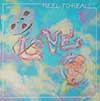The broader music world (or at least “Mojo” or “Classic Rock” readers) will know Love for their 1967 album “Forever Changes”, a classic blend of psychedelica and orchestration, a masterwork that’s rightly lauded as one of the greatest LPs of all time.
“Reel to Real” is not “Forever Changes” by any stretch but it’s still a formidable mix of urgent, straight-ahead and sometimes rock-funk coloured by Lee’s killer voice and singular lyrical vision.
By 1974, Arthur Lee was all but over the music business. He’d sacked his earlier bands and was onto his third record label. He was signed to Robert Sigwood's RSO and “Reel to Real” was the last time he’d appear on a major imprint.
Love had been an oddity of their time, being a white act fronted by a black man, and also the band whose success was what the nascent Doors aspired to.
Time had moved on. Lee had turned his back on the highly-arranged shoulda-been-hits of “Forever Changes”, sometimes refusing to play the material live even though it had made a substantial dent in the UK.
He’d tried his hand at the sort of hard-edged blues-rock that had been explored - and bent out of shape - by his good mate Jimi Hendrix and he’d go back there in years to come. “Real to Reel” took him, metaphorically speaking, out of his Los Angeles mindset and back to his Stax southern soul roots.
The Stax label really was the Stones to Motown’s Beatles. Stax’s output hit the national charts but was generally less commercial than its Motor City counterpart’s - and earthier.
RSO didn’t want earthy. They wanted another “Forever Changes” - and therein lies the tale of the tape. Love would tour on the back of this with stadium heavyweights like Eric Clapton and Lou Reed but “Reel to Real” would disappear without a trace. Lee would continually kick against the pricks, petulantly playing the difficult artist. Ultimately, he fell off the RSO roster and spent years in seclusion, on indie labels and then in jail, before a re-birth in the ‘90s.
High Moon has done a sterling job on this re-issue with a generous wad of outtakes and alternate mixes that bumps out “Reel to Real” to a double album. David Fricke’s liners are bang-on the money and there are enough candid shots of Lee and the band to make the booklet a fascinating read.
Sonically speaking, this is a big production. Horns and chick vocals abound. The guitar-playing of John Sterling and Melvan Whittington is strong, fluid and varied, while future Rolling Stone auditioner Harvey Mandel chips in (on the James Brown-like “Which Witch is Which”.) It’s the rolled gold rhythm section of Joe Blocker and bassist Sherwood Akuna however that shapes the sound.
As amazing as Jimi was when carving a canyon through rock and roll, it’s his latter-day, funkier offerings that keep me coming back. In the same way, there’s enough meat here to make multiple serves of “Real to Reel” similarly filling. It’s funky but rocking.
Be warned: There are a couple of ordinary songs. "Who Are You?" is tighter than a fish's arsehole but groans under all those Jan Hammer-style/"Miami Vice" synths. "You Said You Would" has some nice slide guitar but the treated gunshot percussion is madly overdone.
I’ve read criticism that Lee’s vocals were a letdown on this. Not so. He might have been an erratic, annoying and intuitive person to produce but his vocals are mostly magnificent throughout. The outtakes include some previously lost rockers and a relaxed revisiting of a “Foreveer Changes” cast-off, “Wonder People (I Do Wonder)”.
“Reel to Real” isn’t Love’s best by a long way but it’s no “Out Here” either. It has much to recommend.





 Let’s make the assumption that many people reading this will never have heard anything from Californian band Love’s substantial back catalogue and they’ll barely know the band’s singer and only constant member, the late Arthur Lee.
Let’s make the assumption that many people reading this will never have heard anything from Californian band Love’s substantial back catalogue and they’ll barely know the band’s singer and only constant member, the late Arthur Lee.